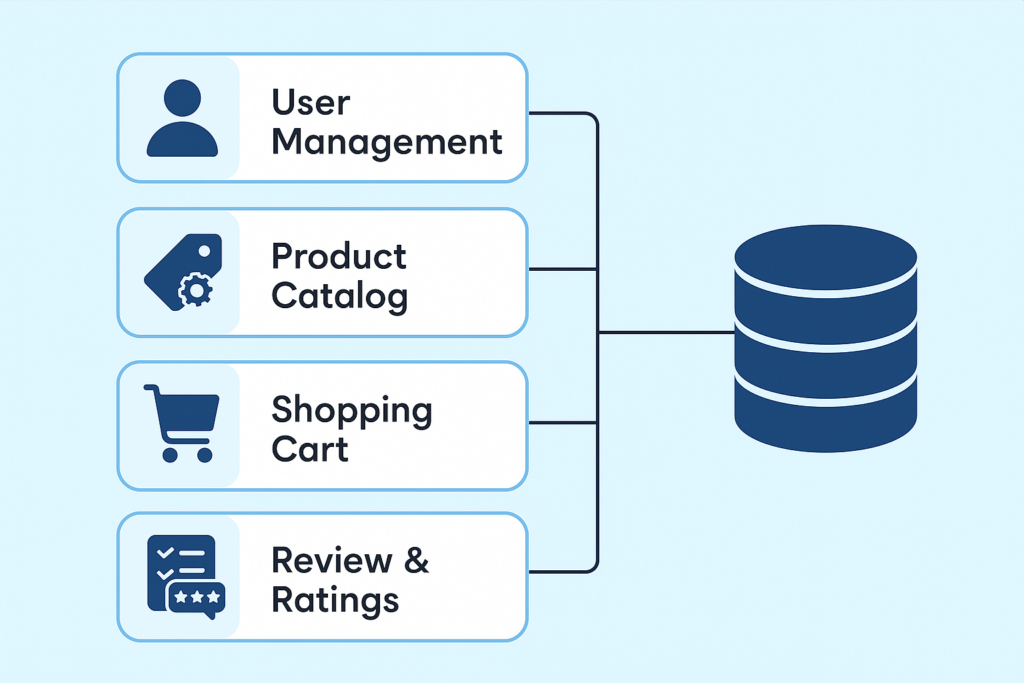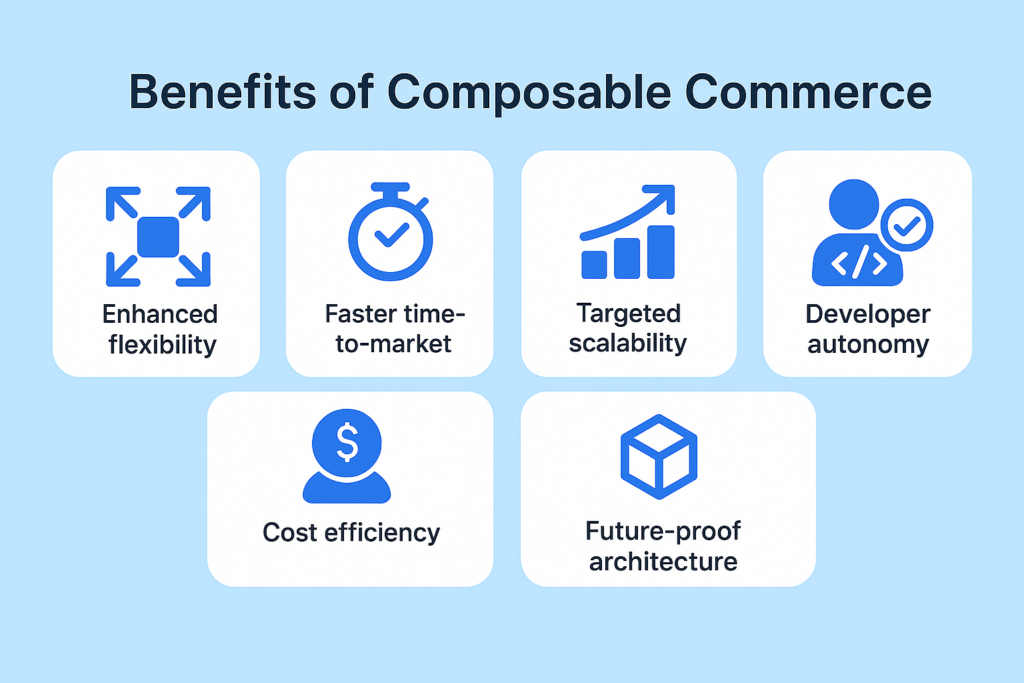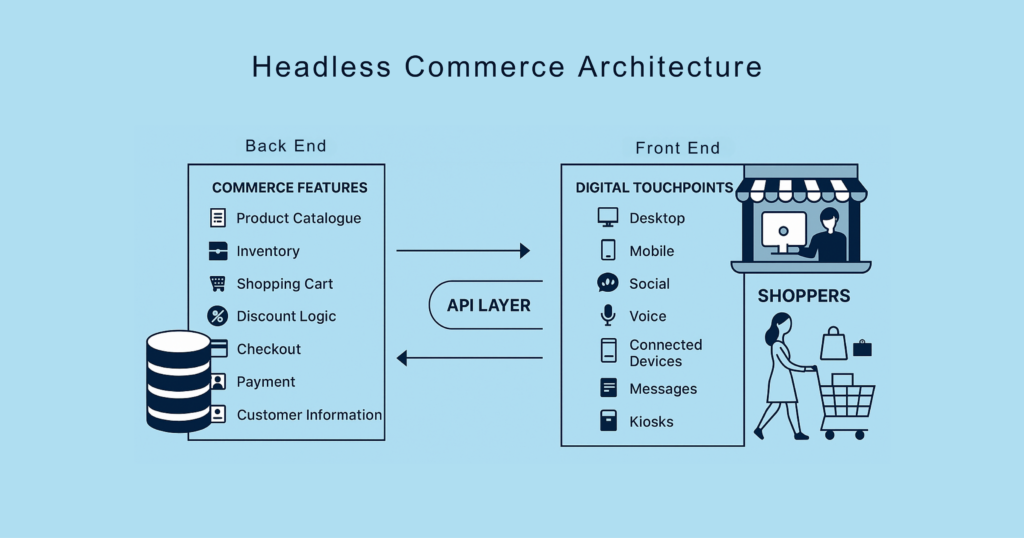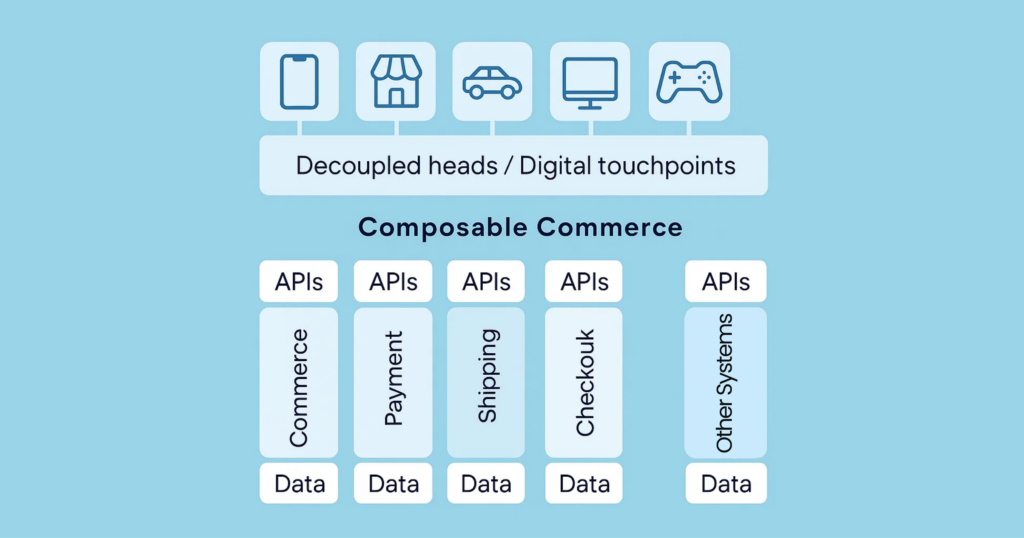
In the early wave of digital retail, many mid-market companies leaned into all-in-one e-commerce platforms. Back then, simplicity was a strength—these systems offered convenience, control, and just enough capability to compete.
But today, that same simplicity is holding them back.
Caught between nimble startups and enterprise giants, mid-market brands face pressure to move faster, scale smarter, and deliver highly personalized experiences. Yet many are shackled to legacy systems where even a small update—like tweaking a storefront or adding a payment method—can spiral into a multi-week project.
The root of the problem? Most legacy platforms were built as monoliths—all parts of the system (storefront, checkout, CMS, database) are tightly bound together. Touch one thing, and the whole stack feels it. This leads to sluggish development cycles, limited agility, and rising operational costs just to stay functional.
That’s why a growing number of mid-market enterprises are turning to composable commerce, a modular, API-first approach where businesses build their tech stack choosing best-in-class tools for search, payments, content, and more. Each service functions independently yet works together seamlessly. It’s agile, scalable, and designed for change.
This shift is more than technical. It’s strategic – one that lets mid-sized brands build with the freedom, speed, and innovation today’s market demands.
The limitations of legacy e-commerce platforms
As digital expectations evolve, many mid-market enterprises are finding that their legacy e-commerce platforms no longer support the speed, scale, or personalization required to compete. What once seemed like a complete solution—an all-in-one platform with everything bundled together—has become a liability. These systems were designed for a different era of commerce, and they often struggle to keep pace with the demands of today’s connected, multi-channel customers.

While legacy platforms may still power day-to-day operations, they create friction at every turn when it comes to growth, adaptability, and customer experience.
- Platform changes are slow and risky, with tightly coupled architecture making every update a potential disruption to the broader system.
- Launching new features or campaigns takes longer than necessary, creating delays that reduce competitiveness.
- Integration with modern tools and technologies—such as AI, advanced analytics, or headless front ends—is difficult or sometimes impossible.
- Performance suffers under traffic spikes, leading to inconsistent site reliability during high-demand periods.
- Global and omnichannel expansion is difficult to implement without extensive custom development.
- Personalization is limited by rigid templates and siloed data, preventing tailored experiences across channels.
- Operational costs rise over time due to constant maintenance, technical debt, and the need for custom workarounds.
- Marketing and development teams lack the autonomy to move quickly, often relying on IT teams for even small adjustments.
- User experience suffers from slow page loads, outdated design limitations, and disconnected touchpoints that drive customers away.
According to The 2025 Digital Commerce Landscape Report, 72% of organizations acknowledge that their legacy technology is holding them back from staying competitive. Additionally, 43% report ongoing struggles integrating their existing commerce platforms with third-party tools. These challenges are especially critical for mid-market enterprises to weigh as they plan to scale, expand into new channels, or modernize their digital operations.
Embracing composable commerce: benefits and advantages

As mid-market enterprises work to modernize their commerce infrastructure, composable commerce stands out as a smarter, more flexible alternative to traditional platforms. Rather than being confined to a single vendor or rigid system, businesses can assemble a tech stack that fits their specific needs—choosing tools for search, payments, content, and more, all connected via APIs. This modular architecture empowers teams to adapt quickly and build a commerce experience that evolves with their goals.
Some of the most impactful benefits include:
- Enhanced flexibility to integrate best-in-class solutions and adjust components over time without major system overhauls.
- Faster time-to-market, with the ability to launch updates, features, and customer experiences independently and without bottlenecks.
- Targeted scalability that allows specific services to handle demand peaks without the need to scale the entire infrastructure.
- Cost efficiency through selective adoption and usage-based pricing, which helps reduce upfront investment and lowers total cost of ownership.
- Improved developer autonomy, allowing tech teams to build, test, and deploy individual components without waiting on full-platform updates—accelerating innovation and reducing internal friction.
- Future-proof architecture that evolves with the business, making it easier to adopt new technologies, enter new markets, or shift strategies without costly replatforming.
With composable commerce, mid-market enterprises can move beyond the limits of traditional platforms. By embracing a modular approach, they gain the flexibility, speed, and scalability needed to stay competitive—and the freedom to shape their commerce strategy on their own terms.
Composable Commerce vs. Headless Commerce
Composable commerce and headless commerce are often mentioned in the same breath—but they’re not the same thing. While closely related, each serves a different purpose in the evolution of modern e-commerce architecture.
Headless commerce is the practice of decoupling the frontend—the part users interact with—from the backend system that manages products, payments, and orders. This approach gives developers the freedom to design custom storefronts without being restricted by out-of-the-box templates or themes. For example: A company might use Shopify or BigCommerce as a backend engine but design a completely custom frontend using React or Vue.js.

Composable commerce goes a step further. It breaks down every part of the commerce stack into modular, interchangeable components—like search, CMS, checkout, payments, and more. Businesses can then choose best-in-class tools for each of those functions and connect them via APIs, creating a tailored system that adapts with them as they grow. For example, a company uses commercetools for catalog, cart, and checkout, Algolia for search, Stripe for payments, and Contentful for CMS—each chosen specifically because it’s the best fit.

So why are they mentioned together? Because headless commerce is often the first step toward composable commerce. Once the front end is decoupled, businesses can begin replacing other parts of their stack with more flexible, high-performing alternatives.
Think of it like this:
- Headless = “I want to customize how my store looks and feels.”
- Composable = “I want to customize everything—how it looks, how it works, and how it scales.”
Headless lays the groundwork. Composable takes the full leap.
Platforms leading the way
As more businesses embrace modular, flexible architectures, several platforms have emerged as clear leaders in the composable commerce space. These platforms prioritize API-first design, scalability, and freedom of integration—giving mid-market and enterprise brands the tools they need to build best-in-class digital experiences.
Here are some of the most prominent players:
- Spryker: Specializing in enterprise-grade commerce solutions, Spryker offers a highly modular, API-based platform designed for complex B2B, B2C, and marketplace scenarios. Its unique Packaged Business Capabilities (PBCs) allow businesses to tailor every aspect of their digital operations for maximum flexibility and innovation.
- commercetools: Widely seen as a pioneer in composable commerce, offering a cloud-native, API-first platform built on microservices. Its MACH (Microservices, API-first, Cloud-native, Headless) gives businesses full control to scale and swap components as needed.
- Shopify enterprise (plus + hydrogen): brings composability to its robust ecosystem with the Hydrogen framework and Storefront API, enabling highly customized storefronts while maintaining backend simplicity—ideal for DTC and mid-market brands.
- Elastic Path: focuses on flexibility for complex commerce needs, offering API-first tools and cloud-native scalability that support unique customer journeys and fast integrations.
- BigCommerce: combines composable capabilities with out-of-the-box usability, supporting API-driven development and easy integration with popular CMS and frontend tools—perfect for brands seeking both control and convenience.
These platforms vary in complexity, pricing, and capabilities, but they share a common mission: to empower businesses to build commerce systems that fit them—not the other way around. With composable commerce, brands are no longer forced to choose between control and convenience. They can have both.
From Harry Rosen to Lady Gaga: Retail leaders reinvent with composable commerce
Retailers worldwide are turning to composable commerce to meet rising customer expectations and escape the limitations of legacy systems. This shift allows them to build flexible, scalable ecosystems that support innovation and deliver personalized experiences across every channel.
One such example is Harry Rosen, a Canadian luxury menswear brand that accelerated its transition to composable commerce with commercetools during the pandemic. The brand digitized its signature high-touch service through personalized styling consultations and shoppable content, boosting content value by 300% and creating a seamless omnichannel experience that strengthened customer loyalty.
Similarly, Carrier—a global HVAC leader—adopted a composable approach using Shopify’s modular architecture to launch its OneCommerce accelerator. This initiative enabled regional business units to deploy tailored e-commerce experiences in under 60 days at a fraction of traditional costs. By standardizing 85% of functionality and allowing for regional flexibility, Carrier dramatically reduced time-to-market and built a scalable foundation for global digital growth.
Meanwhile, John Lewis & Partners, The Very Group, and River Island have also embraced composable commerce with commercetools to modernize their customer experiences. John Lewis cut product ingestion time from days to minutes; The Very Group improved speed and operational efficiency; and River Island introduced RFID-powered self-checkout, now used in up to 70% of in-store transactions.
Lastly, the official Lady Gaga Store shows how composable commerce can support bold, dynamic brand experiences. By transitioning from a traditional Shopify setup to a Hydrogen-powered architecture integrated with Sanity CMS, her team reimagined the storefront with features like a 3D album showcase, mood-based backgrounds, and immersive content layouts. This modular approach created a flexible, content-rich environment aligned with the fast-paced demands of the music industry, while offering fans a more engaging and interactive shopping experience.
Building for the future with composable commerce
The momentum behind composable commerce is undeniable. For mid-market enterprises striving to stay competitive, it offers a clear path to greater agility, faster innovation, and deeper customer connections. By moving away from rigid, one-size-fits-all platforms and toward modular ecosystems built for change, businesses can create digital experiences that are truly their own. As customer expectations continue to evolve and new technologies emerge, the brands that embrace composability today will be the ones shaping the future of commerce tomorrow.
If you’re exploring how composable commerce could fit into your growth strategy, we’d love to start the conversation. Reach out to us—let’s imagine what’s possible together.


